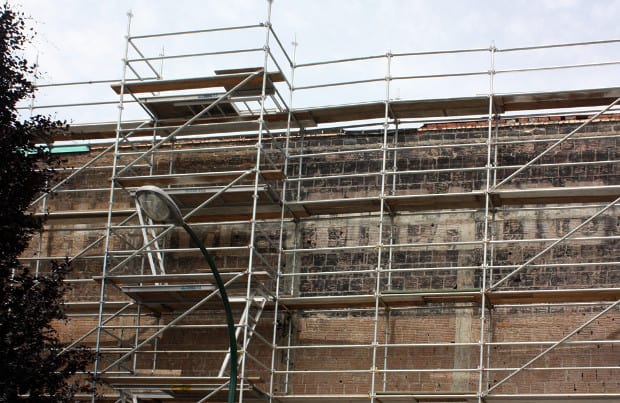17 Nov 2012
A novel approach to ghostsign conservation from Vancouver

This ghostsign for the Little Theatre in Vancouver is the subject of a unique preservation effort prompted by the efforts of the Grandview Heritage Group. In response to a letter sent to the developers currently at work on the building they have been told that two actions will be taken to preserve the sign. First is that it will protected by a covering that can be removed when technology becomes available to coat or treat the sign. Second is that a replica of the lettering in its current state of fade will be created on the front of the new theatre as a tribute to the original.
Clearly a lot of thought has gone in to considering the options available. For me there are three possible routes for any given sign: first, taking no action and letting it gradually fade into nothing; second, repainting it; third, using technology to protect it from the elements and ‘freezing’ it in its current state of decay. None of these seems entirely satisfactory but most signs are either left alone or restored to their former glory.
What is novel in this instance is that they have opted for the third way, effectively halting further fading in the hope that a technological solution will become available in the future. As an intervention, I believe this is more authentic than repainting, essentially it preserves the sign in the closest possible state to the painted original. However, there is also an interference with the natural life cycle of the sign which detracts from this authenticity. In this case the original sign will be obscured from view indefinitely which deprives others of seeing it fade gracefully in the hope that some way will be found to arrest this decay.
It would probably go without saying that efforts should be made to preserve inscriptions and wall paintings from the ancient and pre-historic worlds. However there is clearly widespread disagreement about doing the same for ghostsigns from our relatively recent history, but in many years these will similarly become ancient history.
The distinction for me is the nature of survival. Those examples from the ancient world made their way through the course of history alone and with no protection. The same can be said of the ghostsigns that we see around us today. As noted by Michael Copeman in this article, “it is the fact that such things survive only rarely and accidentally that gives them their charm and fascination”.
The key question is at what point does their survival merit preservation efforts? I suppose that this will be answered on a case by case basis and in response to community and other activists such as the Grandview Heritage Group. I’ll write again once work on the replica is complete and perhaps again in many years once the covering on the original is removed.
[More posts on protection and posts on ghostsigns restoration.]


